|
|
Electrocatalytic Hydrogen Evolution Performance of Two-dimensional Mo2CTx MXene Materials: A Review from Preparation to Application
ZOU Minmin, LIU Jingxin, HU Haolin, ZENG Dongmei, ZHANG Ting, ZHANG You
2025 Vol. 40 (11): 1173–1187
 Abstract
Abstract(
296 )
 HTML
HTML(
2)
 PDF
PDF(4305KB)(
929
)
MXenes, an emerging family of two-dimensional (2D) materials with high electronic conductivity, large specific surface area, good hydrophilicity, and regulable surface functional groups, have shown broad application potential across the domains of energy, catalysis, corrosion prevention, and electromagnetic shielding. Among numerous MXenes, Mo2CTx MXene has attracted much attention due to its excellent electrocatalytic hydrogen evolution activity. This paper aims to systematically review its preparation and current research status in the field of electrocatalytic hydrogen evolution, providing a comprehensive and clear reference framework for further in-depth study. The synthesis methodologies and exfoliation techniques in recent years are comprehensively reviewed, the important role as an electrocatalyst for hydrogen evolution reaction (HER) is summarized, and the optimization strategies for improving catalytic performance of HER are addressed from perspectives of terminated group modification, elemental doping, and hybridization. Finally, a prospective outlook regarding Mo2CTx MXene-based composites in the realm of electrocatalytic hydrogen evolution is presented. Despite significant research advancements on Mo2CTx MXene, the absence of eco-friendly and scalable preparation methodologies remains a critical challenge, contributing to elevated production costs. Additionally, the delayed progress in catalytic mechanism investigations hinders the formulation of rational design strategies. Henceforth, efforts should focus on developing green, fluorine-free synthetic approaches to facilitate large-scale material production, concurrently enhancing catalytic activity and catalyst stability, and accelerating the exploration of catalytic mechanisms. These endeavors are critical to advancing the practical application of Mo2CTx and its composite materials in the field of electrocatalytic hydrogen evolution.
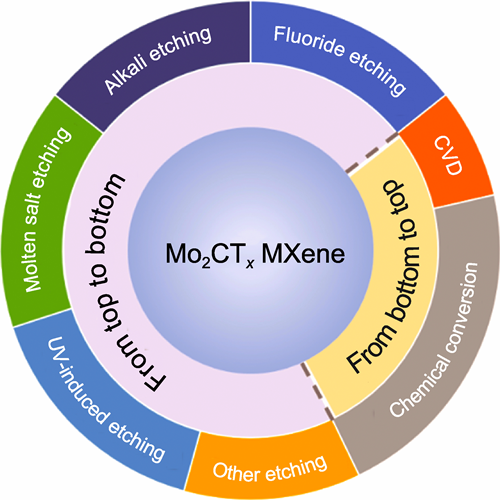
|
|
|
Stress in CVD Diamond Films: Generation, Suppression, Application, and Measurement
LI Chengming, ZHOU Chuang, LIU Peng, ZHENG Liping, LAI Yongji, CHEN Liangxian, LIU Jinlong, WEI Junjun
2025 Vol. 40 (11): 1188–1200
 Abstract
Abstract(
316 )
 HTML
HTML(
1)
 PDF
PDF(850KB)(
781
)
Diamond with excellent properties and broad application prospects in the fields of thermal management of optics and electronic devices, and wide bandgap semiconductors, is known as the ultimate semiconductor. As an optical window, a large-sized CVD (chemical vapor deposition) diamond free-standing thick film with a thickness of ≥2 mm is required. In semiconductor heat dissipation, a diamond free-standing film with a diameter over 4 inches (1 inch=2.54 cm) and a thickness of 100 μm is required to bond with semiconductor materials such as gallium nitride (GaN). However, there still exist significant difficulties in synthesis and application of large-area CVD diamond films. On the one hand, stress during the deposition process can cause the diamond film to rupture. On the other hand, residual stress can cause the diamond film to warp, resulting in poor bonding quality. Therefore, controlling the stress of diamond films has become a key issue for the large-scale and widespread application of diamond films. This article summarizes the classification, sources, and influencing factors of CVD diamond stress, and provides a detailed introduction to measures for suppressing stress in diamond films. Furthermore, researches on improving diamond properties by artificially applying stress are summarized, including changing diamond bandgap and increasing diamond thermal conductivity under stress. Finally, a method and theoretical calculation formula for evaluating the stress magnitude of diamond are provided, and the future trend of stress research on diamond films is analyzed.

|
|
|
Interface Regulation of Electrochemical Potential in NASICON-type Ceramic Solid-state Batteries
LI Yongfeng, GU Yuping, SHI Guangzhao, HU Jiulin, LEI Meng, PENG Hui, ZENG Yuping, LI Chilin
2025 Vol. 40 (11): 1201–1211
 Abstract
Abstract(
649 )
 HTML
HTML(
1)
 PDF
PDF(2561KB)(
68
)
Li1.3Al0.3Ti1.7(PO4)3 (LATP), one of the NASICON-type solid-state electrolytes, possesses a high ionic conductivity, excellent chemical stability, and high shear modulus (40-60 GPa). However, the tetravalent titanium ion in LATP is particularly prone to undergo reduction reaction with lithium metal during cycling, leading to the structure degradation and electron introduction in LATP electrolyte. In order to maintain the chemical and electrochemical stability of LATP, this work modified the surface of LATP solid electrolyte with a Prussian blue (PB) interfacial layer to optimize the contact between electrolyte and anode. Using PB with abundant open-frame lithium ion diffusion channels as the mixed conductive modification layer has several advantages. (1) Intrinsic conductivity of PB layer is enhanced after lithiation, accelerating homogenized transmission of electrons from the interfacial layer to the negative electrode. (2) Lithiation process is accompanied by enhancing lithium affinity of PB intermediate layer, which enables the interface contact between LATP and lithium metal to be closer during the electrochemical process. (3) Lithiated PB still maintains a three-dimensional skeleton structure, which is conducive to the homogenization effect of lithium ion flux at interface, thereby promoting stabilization of lithium deposition/stripping process. (4) The PB with metal-organic framework (MOF) structure is conducive to ensuring the mechanical stability of interface during cycling and reducing volume change of lithium negative electrode. (5) The PB structure does not collapse after lithiation, not easy to cause phase separation and additional phase boundaries or phase gaps, which is conducive to the integration of lithium ion flow and electron flow. (6) More uniquely, redox potential of PB is higher than those of lithium metal and LATP on both sides of the PB interface, conducive to the formation of an electron transport barrier between Li and LATP, and prevents the reduction and degradation of LATP. The improved solid-state battery has good cycling stability and kinetic performance. At a current density of 0.025 mA·cm-2, the PB-modified Li/Li symmetric solid-state cell can achieve a stable cycle of 800 h. After 160 cycles at a current density of 0.025 mA·cm-2, the capacity of PB-modified Li/LiFePO4 solid-state battery is still close to 200 mAh·g-1. The modified Li/FeF3 solid-state battery can be operated at 0.025 mA·cm-2 with the preservation of a high Coulombic efficiency, indicating that the PB modification has good tolerance to the volume change generated during electrochemical cycling.

|
|
|
Electrolytic CO2 Performance of La0.3Sr0.6Ti1-xNixO3-δ-based Fiber Fuel Electrode for Solid Oxide Electrolysis Cell
WANG Hongbin, WANG Leying, LUO Linghong, CHENG Liang, XU Xu
2025 Vol. 40 (11): 1212–1220
 Abstract
Abstract(
95 )
 HTML
HTML(
1)
 PDF
PDF(1841KB)(
47
)
Interface engineering is an effective strategy to develop fuel electrode materials with excellent catalytic activity of CO2 for solid oxide electrolysis cell. In this study, La0.3Sr0.6Ti1-xNixO3-δ/Ce0.9Gd0.1O2-δ (LSTNx/GDC) composite fibers were directly prepared by electrospinning technology, by which novel fiber-based fuel electrodes were constructed with LSTNx as electronic channel skeleton, GDC as embedded ion channel and in-situ Ni as exsolution nanoparticles. Effect of B-site Ni-doping on the morphology, structure and CO2 catalytic activity of the fiber-based fuel electrode was studied. The results of SEM observation reveal that the LSTNx/GDC composite fibers with uniform diameter (100-150 nm) and without obvious particle agglomeration or fracture gap are successfully prepared when the Ni-doping coefficient (x) is 0.15 or 0.20. More in-situ B-site nickel nanoparticles (sizes between 20 and 30 nm) could be exsolved from the prepared fuel electrode under reducing atmosphere. The relaxation time distribution analysis confirms that in-situ exsolution of B-site nickel metal nanoparticles can not only provide more active sites, but also form rich heterointerfaces with composite fiber, accelerating the interfacial charge transfer, significantly increasing the adsorption and enhancing the catalytic ability of CO2. Electrolytic current density of the single cell (with the doping coefficient of 0.20 at 850 ℃, CO2 : H2 at 5 : 5 (in volume) under 1.5 V) increases to 0.799 A·cm-2 while polarization impedance decreases to 0.171 Ω·cm², presenting excellent stability without significant current fluctuation up to 70 h.

|
|
|
Composite Yolk-shell NiCo2V2O8@TiO2@NC Material as Anode for Lithium-ion Batteries
ZHANG Yuting, LI Xiaobin, LIU Zunyi, LI Ning, ZHAO Yu
2025 Vol. 40 (11): 1221–1228
 Abstract
Abstract(
199 )
 HTML
HTML(
1)
 PDF
PDF(2497KB)(
64
)
Transition metal vanadates, as an advantageous anode material for lithium-ion batteries, currently have bottlenecks such as unsatisfied conductivity and cycle stability caused by drastic volume changes during charging and discharging. In this study, NiCo2V2O8@TiO2@NC material with a multi-level composite core-shell structure was prepared using a step-by-step coating strategy to improve this defect. Initially, yolk-shell structured NiCo2V2O8 nanospheres were synthesized as the precursor through hydrothermal synthesis and ion exchange methods. Subsequently, a robust TiO2 layer and a nitrogen-doped carbon (NC) network structure were coated on the surface, resulting in formation of a hierarchical mesoporous nanostructure. The specific yolk-shell nanosphere structure provides abundant channels for Li+ transport in NiCo2V2O8, a promising electrochemical active material. Further coating with a TiO2 layer not only enhances the stability and durability of the material, but also offers additional electrochemical active sites. Moreover, introduction of the nitrogen-doped carbon network structure not only improves conductivity of the ordered multi-level core-shell NiCo2V2O8@TiO2@NC material but also facilitates rapid electron transport, further optimizing its electrochemical performance. When lithium-ion battery anode materials were prepared under optimal conditions, the obtained cell exhibited an initial specific capacity of 1422.0 mAh∙g-1, which remained 1011.9 mAh∙g-1 after 500 cycles, corresponding to a specific capacity retention rate of 71.2%. This material demonstrates high specific capacity, good rate performance, and excellent cycle stability, displaying promising prospective for a wide range of applications in energy storage devices.
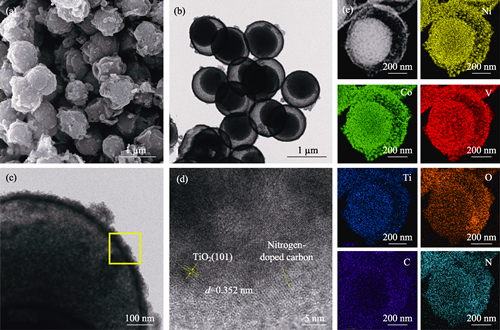
|
|
|
First-principles Study on Oxygen Evolution Reaction Activity of CoPS3 Quantum Dots Edge States Modified with Oxygen
HU Xuemin, ZHANG Xingjian, JIANG Zhihao, HUANG Liwen, DING Kaining, ZHANG Shengli
2025 Vol. 40 (11): 1229–1236
 Abstract
Abstract(
135 )
 HTML
HTML(
1)
 PDF
PDF(3183KB)(
206
)
Two-dimensional CoPS3 electrocatalyst for water splitting suffers from scarcity of in-plane metal active sites, resulting in slow kinetics for oxygen evolution reaction (OER) at anode, thereby limiting overall efficiency of hydrogen production via water splitting. To address this issue, this study proposes a new strategy to enhance the catalytic activity through synergistic effects of quantum confinements and edge chemical modification. Initially, two typical CoPS3 quantum dots (CoPS3-QDs) structures with high edge-site densities were constructed. Through binding and bond energy calculations, structure of thermodynamically stable CoPS3-QDs1 was identified, with its edge Co2 site exhibiting the best OER activity among other edge sites (Gibbs free energy change for the rate-determining step, ΔG at 1.68 eV). Subsequently, oxygen modification was introduced at Co2 site of the CoPS3-QDs1 and its neighboring sulfur atoms, obtaining five O-CoPS3-QDs models. Theoretical calculations revealed that the M4 model (with O modification at the S3 site) had an overpotential (ηOER) of only 0.32 V, which was 29% lower than that of the unmodified system but significantly better than that of the noble metal catalyst RuO2 reported in the literature. Partial density of states analysis further revealed that O modification optimized charge redistribution around the Co sites, enabling moderate adsorptions of oxygen intermediates (*OH, *O, *OOH). This study elucidates the crucial role of edge-site modification of quantum dots in regulating electronic structure and reaction kinetics, providing a theoretical basis for designing efficient and low-cost OER electrocatalysts.
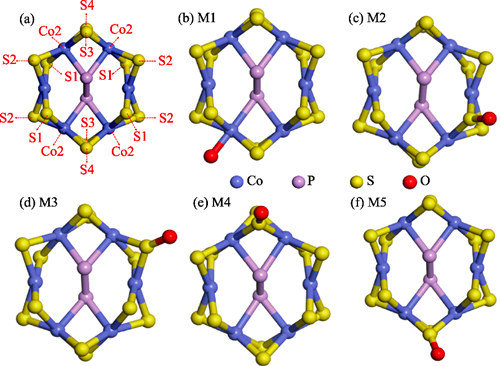
|
|
|
Flexible Cu0.005Bi0.5Sb1.495Te3 Thin Films: Magnetron Sputtering Preparation and Thermoelectric Properties
GE Zesheng, LIU Miao, TANG Zhe, ZHOU Yan, WAN Shun, ZONG Peng’an
2025 Vol. 40 (11): 1237–1244
 Abstract
Abstract(
169 )
 HTML
HTML(
4)
 PDF
PDF(3344KB)(
321
)
Bismuth telluride-based materials have been extensively studied due to their outstanding thermoelectric performance at room temperature. However, bismuth telluride is inherently brittle, which poses a significant challenge in developing flexible bismuth telluride-based materials with high thermoelectric performance remains in thermoelectric research. In this study, a non(00l) layered flexible p-type thermoelectric thin film was fabricated by depositing Cu0.005Bi0.5Sb1.495Te3 onto polyimide (PI) substrates using magnetron sputtering technology, with a systematic investigation of the effect of sputtering pressure on thermoelectric properties. The results show that at 0.7 Pa sputtering pressure, its mobility is enhanced due to the large grain size and high crystallinity, its carrier concentration is optimized to 5.78×1019 cm−3, and its room-temperature power factor (PF) reaches 1660 μW·m−1·K−2. In addition, the film exhibits excellent mechanical flexibility, showing less than 10% variation in resistivity at a bending radius of 5 mm and less than 5% variation in Seebeck coefficient after 600 cycles of bending. Furthermore, a flexible thermoelectric device comprising four p-type thermoelectric legs (5 mm×25 mm×767 nm) was designed and fabricated based on this film. The device demonstrates promising performance, generating an output voltage of 18.5 mV, with a power density reaching 44.80 μW·cm−2 under a temperature difference of 30 K. Touch-sensitive linguistic output design of the device demonstrates promising potential for language assistance applications. This work provides valuable insights into the magnetron sputtering preparation of high-performance flexible bismuth telluride-based thermoelectric materials and the optimization of their properties.
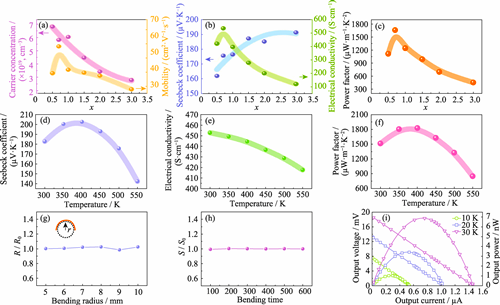
|
|
|
Preparation of p-type GeMnTe2 Based Thermoelectric Materials with Stable Cubic Phase
ZHANG Haifeng, JIANG Meng, SUN Tingting, WANG Lianjun, JIANG Wan
2025 Vol. 40 (11): 1245–1251
 Abstract
Abstract(
123 )
 HTML
HTML(
1)
 PDF
PDF(2553KB)(
49
)
p-type GeTe based thermoelectric (TE) materials have attracted significant attention owing to their remarkable TE performance in medium and low temperature range (300-800 K). However, the material undergoes a phase transition from rhombohedral to cubic in the temperature range of 600-700 K, inducing changes in the coefficient of thermal expansion that limit its application in TE devices. Consequently, it is imperative to develop stable GeTe based thermoelectric material free from phase transitions. In this study, high temperature melting combined with spark plasma sintering was employed to synthesize GeMnTe2. The as-synthesized samples contain the secondary phase of MnTe2, which increases total thermal conductivity from 1.34 W·m-1·K-1 to 1.81 W·m-1·K-1 at 800 K. By optimizing the chemical stoichiometry of different elements, the formation of MnTe2 secondary phase is suppressed, resulting in stable pure cubic phase GeMnTe1.96. GeMnTe1.96 achieves a maximum zT of ~0.85 at 800 K. This TE material exhibits significant potential for efficient and stable waste heat utilization in the medium temperature range.
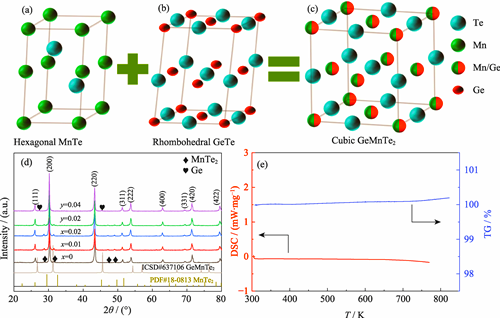
|
|
|
Homogeneity of Zone-melted n-type Bi1.96Sb0.04Te2.70Se0.30 Thermoelectric Material
WU Mingxuan, LI Junjie, CHEN Shuo, YAN Yonggao, SU Xianli, ZHANG Qingjie, TANG Xinfeng
2025 Vol. 40 (11): 1252–1260
 Abstract
Abstract(
123 )
 HTML
HTML(
1)
 PDF
PDF(10992KB)(
98
)
Zone melting technique is an important method for commercial preparation of Bi2Te3-based thermoelectric materials. The zone melting purification process is affected by segregation of materials. However, so far, the effect of zone melting process on the segregation mechanism of Bi2Te3-based materials has not yet formed unified understanding. In particular, increase of material components significantly affects the segregation process and uniformity. In this study, n-type Bi1.96Sb0.04Te2.694Se0.3Br0.006 material was used as the research object, and the melting-zone melting-annealing process was used to systematically explore the influence of zone melting temperature on the composition and uniformity of thermoelectric performance. It was found that the zone melting temperature had a great influence on uniformity of the ingot, and the axial composition segregation was an important factor affecting its uniformity. At high zone melting temperature (≥988 K), the segregation of Bi2Te3-rich phase appeared at the top of the ingot, which made the poor uniformity of thermoelectric properties of the material. The maximum difference of ZT at room temperature in different regions (center top, edge top (ET), center bottom, edge bottom) of samples with zone melting temperatures of 988 and 1003 K reached 31.5% and 28.6%, respectively. Reducing the zone melting temperature to 958 K significantly inhibited the segregation of Bi2Te3-enriched phase, and a cylindrical ingot (inner diameter of 16 mm, height of 55 mm) with excellent thermoelectric properties and uniformity was prepared. The maximum difference of ZT at room temperature in different regions was only 14%, and the maximum ZT of 958 K-ET sample was 1.05 at 350 K. This study reveals the regulation mechanism of zone melting temperature on the composition and thermoelectric performance uniformity of multi-component n-type (Bi, Sb)2(Te, Se)3-based materials, which provides important guidance for the preparation of high-performance thermoelectric materials with excellent uniformity.
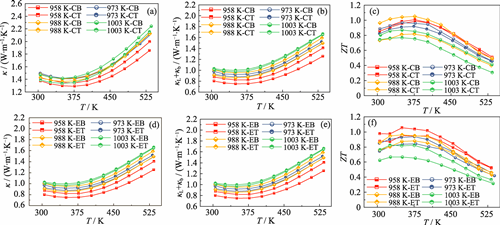
|
|
|
Effect of Acesulfame Potassium Modified SnO2 Electron Transport Layer on Performance of Perovskite Solar Cells
HU Qinghao, LIU Xingchong, PENG Yongshan, HOU Mengjun, HE Tanggui, TANG Anmin
2025 Vol. 40 (11): 1261–1267
 Abstract
Abstract(
273 )
 HTML
HTML(
1)
 PDF
PDF(8202KB)(
259
)
Oxygen vacancy defects at the surface and grain boundaries of tin dioxide (SnO2), an electron transport layer (ETL) material for perovskite solar cells (PSCs), can induce non-radiative recombination, thereby limiting further improvements in device efficiency. This study proposes a low-cost and efficient strategy for modifying the ETL using acesulfame potassium (ACE-K). The results demonstrated that the C=O and S=O groups in ACE-K molecules interact with the undercoordinated Sn4+ on the SnO2 surface, significantly passivating the oxygen vacancy defects in SnO2. Electrical conductivity of the film increased from 4.60×10-6 S·cm-1 to 6.23×10-6 S·cm-1. Moreover, ACE-K modification improved roughness (from 20.6 nm to 14.0 nm) and wettability of the SnO2 film, providing a better substrate for perovskite film growth. Consequently, the perovskite films grown on this optimized ETL enlarged grain sizes from 970.90 nm to 1071.20 nm and enhanced light absorption capability. Space-charge-limited current (SCLC) measurements revealed that the defect density decreased from 4.84×1016 cm-3 to 3.83×1016 cm-3, while electrochemical impedance spectroscopy (EIS) confirmed a significant suppression of non-radiative recombination during charge carrier transport. Ultimately, power conversion efficiency (PCE) of the PSCs improved from 19.27% to 21.60%. In addition, unpackaged ACE-K modified PSCs maintained 91.67% of initial PCE after 2160 h stored in N2, showing excellent long term stability.
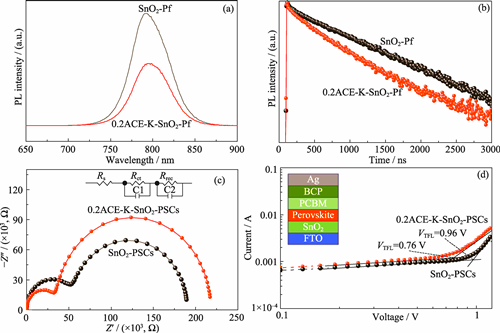
|
|
|
Properties and Mechanism of U(VI) Removal by Calcium Orthovanadate
WANG Hongqin, DENG Hao, LIANG Hua, TIAN Qiang, YAN Minhao, HUANG Yi
2025 Vol. 40 (11): 1268–1276
 Abstract
Abstract(
236 )
 HTML
HTML(
1)
 PDF
PDF(3321KB)(
52
)
Mining process of natural uranium ore generates uranium-containing wastewater, while removal of uranium(VI) from such wastewater has emerged as a critical challenge, requiring urgent resolution in the nuclear industry. Guided by the principle of "from uranium mines, back to uranium mines," this study selected calcium orthovanadate (Ca3(VO4)2) as an adsorbent for U(VI) removal. Adsorption performance of Ca3(VO4)2 powder under varying conditions and its underlying mechanism were investigated. Results demonstrated that under optimal conditions (pH 6, adsorption for 2 h, adsorbent dosage at 0.1 g·L-1, initial U(VI) mass concentration at 120 mg·L-1, temperature at 308 K), Ca3(VO4)2 powder exhibited a high adsorption capacity (1179.92 mg·g-1) and removal efficiency (98.33%) for U(VI). Removal mechanism was attributed to dissolution and mineralization processes, forming metatyuyamunite (Ca(UO2)2(VO4)2·3H2O) on the powder surface after adsorption. Even in the environment of six coexisting ions (Zn2+, Cr3+, Cu2+, Ni2+, Co2+, and Ba2+), Ca3(VO4)2 maintained high adsorption performance, reducing U(VI) mass concentration from 121.49 to 0.1 mg·L-1, which is below the limit specified by the national discharge standard (GB 23727-2020). These findings highlight Ca3(VO4)2 as a promising adsorbent for efficient treatment of U(VI)-containing wastewater.
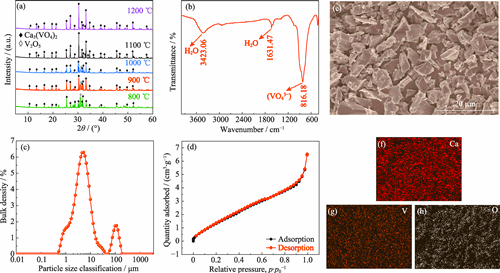
|
|
|
Proton Ceramic Membrane Reactor: Preparation and Low-temperature Ammonia Decomposition Performance
TANG Yang, LIU Limin, ZHOU Xiaoliang, ZHANG Bo, JIANG Xingzhou, JIA Haoyi, LUO Yanlinqing
2025 Vol. 40 (11): 1277–1284
 Abstract
Abstract(
112 )
 HTML
HTML(
2)
 PDF
PDF(3822KB)(
113
)
Ammonia (NH3) has been considered as a hydrogen storage material due to high hydrogen storage density and ease of liquefaction, thus hydrogen (H2) production by ammonia decomposition is an ideal method for hydrogen preparation. However, traditional ammonia decomposition technologies face challenges such as high operating temperatures, low efficiency at moderate temperatures, and difficulties in hydrogen purification. In this study, proton ceramic membrane reactor (PCMR) with symmetric structure of porous electrode Ni-BZCY/BZCY/Ni-BZCY (BZCY: BaZr0.1Ce0.7Y0.2O3-δ) was prepared by co-pressing method. At 600 ℃, PCMR exhibited polarization resistances (Rp) of 0.11 and 0.23 Ω·cm2 in H2 and NH3 atmospheres, respectively, with corresponding current densities of 1.87 and 1.56 A·cm-2 at an applied voltage of 0.8 V. Even at 300 ℃ and 0.8 V, the current densities in H2 and NH3 remained at 0.16 and 0.06 A·cm-2, respectively. The NH3 conversion efficiency of PCMR reached 80% at 600 ℃, improving by 8% compared to bare catalyst material. Even at 350 ℃, an additional improvement of 0.3% can still be attained, and the NH3 conversion efficiency of about 1% was demonstrated even at 300 ℃. This study provides a novel approach to low-temperature ammonia decomposition for hydrogen production.
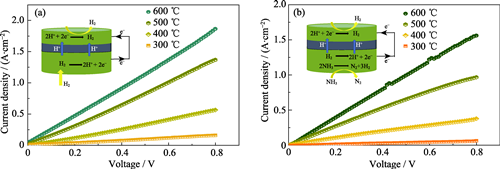
|
|
|
Microstructure and Properties of PIN-PZN-PZ-PT Piezoelectric Ceramics Designed by MPB Linear Rules
XU Xiaoyu, ZHOU Liyang, FENG Xiaoying, WANG Hui, YAN Bin, XU Jie, GAO Feng
2025 Vol. 40 (11): 1285–1292
 Abstract
Abstract(
127 )
 HTML
HTML(
1)
 PDF
PDF(13641KB)(
55
)
High-performance piezoelectric ceramics are indispensable in modern electromechanical systems, and multi-component materials like quaternary Pb(In1/2Nb1/2)O3-Pb(Zn1/3Nb2/3)O3-PbZrO3-PbTiO3 (PIN-PZN-PZ-PT) have attracted significant attention due to their unique properties at the morphotropic phase boundary (MPB). However, to achieve enhanced piezoelectric and thermal performance by design and optimization for MPB compositions through precisely adjusting the PbTiO3 (PT) content is facing major challenges. Here, the ceramics were synthesized using a conventional solid-state reaction method, and the MPB compositions were initially predicted by employing a linear combination rule that accounts for the contributions of each component. The predicted phases were then confirmed by X-ray diffraction (XRD) analysis, followed by comprehensive electrical tests to measure the piezoelectric constant (d33) and Curie temperature (TC). Experimental results reveal that the MPB position is strongly influenced by PT content. As the PT fraction increases, the rhombohedral phase gradually decreases while the tetragonal phase becomes predominant, thus shifting the phase equilibrium. Specifically, the optimal composition (x) ranges are 0.245-0.265 for (1-x)(0.3PIN-0.6PZN-0.1PZ)-xPT, 0.290-0.330 for (1-x)(0.3PIN-0.5PZN-0.2PZ)-xPT, and 0.305-0.345 for (1-x)(0.3PIN-0.4PZN-0.3PZ)-xPT. Notably, the 0.735(0.3PIN-0.6PZN-0.1PZ)-0.265PT sample exhibits superior performance with a d33 of 425 pC/N and a TC of 253 ℃. These findings demonstrate that precise modulation of the PT content is crucial for controlling the phase balance at the MPB and thereby optimizing the piezoelectric properties. In conclusion, this study successfully identifies the optimal MPB compositions for PIN-PZN-PZ-PT ceramics, highlighting their promising potential for advanced piezoelectric applications and laying a solid foundation for future process improvements and long-term stability research.
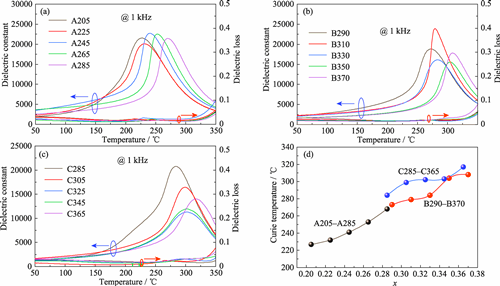
|
|
|
CoMoSSe Alloy with Heterostructure on Carbon Black for Enhanced Electrocatalytic H2 Evolution
REN Xianpei, LI Chao, LING Fang, HU Qiwei, YU Junling, XIANG Hui, PENG Yuehong
2025 Vol. 40 (11): 1293–1299
 Abstract
Abstract(
258 )
 HTML
HTML(
3)
 PDF
PDF(9318KB)(
89
)
Transition metal dichalcogenides (TMDs) recently attracted widespread attention due to their potential application to the electrocatalysis of the hydrogen evolution reaction (HER). However, their HER performance is far inferior to that of platinum (Pt) metal. Preparation of multi-elemental alloy and construction of heterostructure are considered as highly effective methods to enhance hydrogen production activity. Herein, a novel quaternary CoMoSSe alloy with heterostructure was synthesized on the surface of carbon black (CB) particles (CoMoSSe@CB) by a simple Sol-Gel process and thereafter served as HER catalyst. Compared to CoSe@CB and MoS2@CB electrocatalysts, CoMoSSe@CB exhibits superior HER activity with a low overpotential of 190 mV at -10 mA·cm-2 and a Tafel slope of 62 mV·dec-1. This improvement is attributed to the alloying effects among Co, Mo, S and Se, as well as the heterogeneous structure in the composite material, which regulate the electronic structure and intermediate free energy, thereby increasing the number of active sites and enhancing charge-transfer ability. This work can provide new ideas and concepts for designing novel and efficient TMD electrocatalysts.

|
|
|
MnOx/CeO2-ZrO2 Composite Oxides: Construction and Application in Soot Oxidation
LIU Panpan, YAO Peng, LIU Xuzi, QU Li, ZENG Lu, SONG Zhaohua, JIAO Yi, WANG Jianli, CHEN Yaoqiang
2025 Vol. 40 (11): 1300–1308
 Abstract
Abstract(
222 )
 HTML
HTML(
2)
 PDF
PDF(2139KB)(
645
)
Gasoline soot particles pose a severe threat to the ecological environment and human health, but they can be potentially filtered out by using catalytic gasoline particulate filter (cGPF), whose core component is a catalyst coating. To develop more effective catalyst coatings with excellent activity, stability, and water resistance, a kind of composite oxide MnOx/CeO2-ZrO2 was synthesized using different methods, and its soot oxidation performance was evaluated under low O2 concentrations. Herein, MnOx/CeO2-ZrO2 prepared by impregnation (abbreviated as MCZ-IM) exhibits a T50 (temperature required for 50% soot conversion) of 329 ℃ in 1% O2 and 370 ℃ in 0.5% O2, displaying better comprehensive performance when compared to catalysts prepared by high-energy ball milling (abbreviated as MCZ-HB) and co-precipitation (abbreviated as MCZ-CP). Structure-activity relationship reveals that soot oxidation under low O2 concentrations is weakly correlated with textural and structural properties, but strongly depends on the generation and migration of active oxygen species (AOS), especially superoxide (O2-) and peroxide (O22-) anions, which are linked to redox properties, oxygen storage and release capacity, as well as amount of oxygen vacancies. The impregnation method enhances oxygen species adsorption, activation and desorption more effectively, endowing it with a more effective approach to enhancing AOS generation and mobility. Therefore, this study not only provides a preparation strategy for particulate matter oxidation catalysts applicable to actual operating conditions, but also offers insights into the migration of AOS at low O2 concentrations.
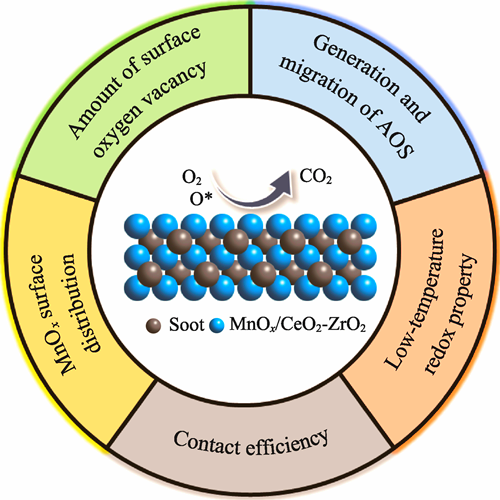
|
|